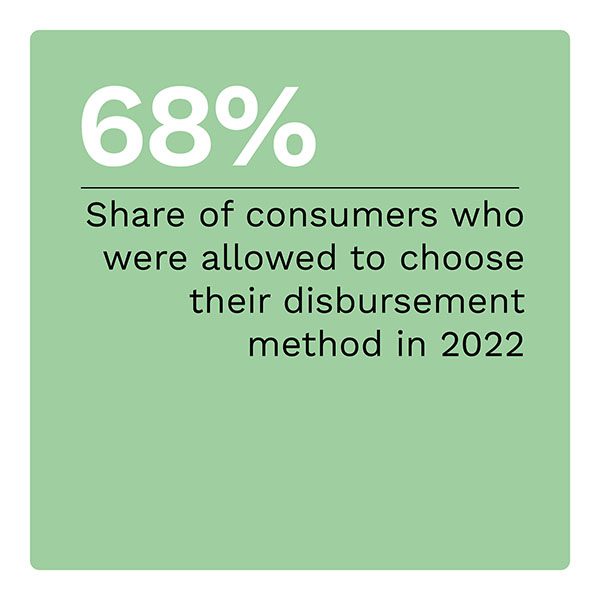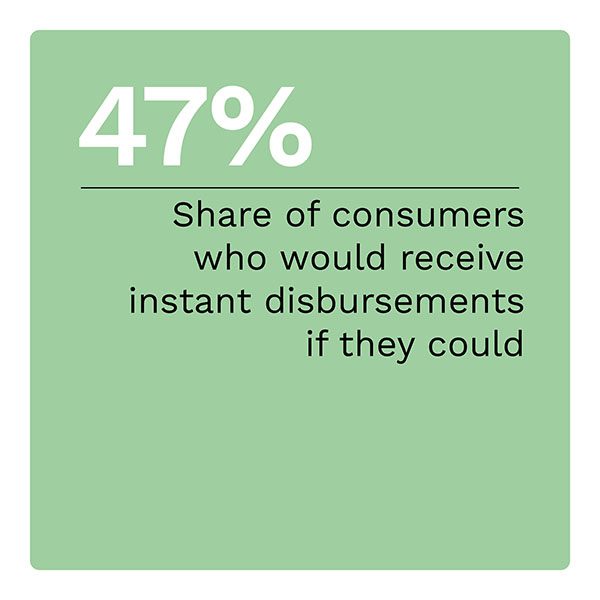PYMNTS research found that 47% of U.S. consumers would choose an instant disbursement if possible — a share that has risen steadily since 2020. Most consumers, however, are never given the option. Consumers see fewer options, especially among those receiving winnings, legal settlements and insurance payouts. This lack of choice is a critical obstacle to instant payments’ growth.
The “Money Mobility Tracker®” explores the advantages gained by businesses adopting faster payments and how instant disbursements are becoming a vital component of the customer loyalty equation.
Around the Money Mobility Space
While instant disbursements reached a five-year high in the insurance industry in 2022, insurers are offering the option to fewer clients than the previous year. PYMNTS research found that consumers choose instant payouts 23% of the time, with automobile claim payouts (27%), life insurance claims (26%), property and casualty claims (20%) and healthcare claims (20%) the most popular instant insurance disbursements.
 Among the faster payments options gaining traction with consumers are money-storing apps. Thanks to their speed and convenience, 37% of consumers used general storage apps, such as PayPal, and 15% used both general and merchant-specific apps, delivering increased customer spend and greater customer loyalty to merchants. Rewards are proving to be a big attraction, with 46% saying they would use general purpose apps if offered rewards, compared to 18% interested without rewards.
Among the faster payments options gaining traction with consumers are money-storing apps. Thanks to their speed and convenience, 37% of consumers used general storage apps, such as PayPal, and 15% used both general and merchant-specific apps, delivering increased customer spend and greater customer loyalty to merchants. Rewards are proving to be a big attraction, with 46% saying they would use general purpose apps if offered rewards, compared to 18% interested without rewards.
For more on these and other stories, visit the Tracker’s News and Trends section.
An Insider on Open Banking’s Power to Deliver Faster Payments
Open banking rails in the United Kingdom offer instant settlement, lower fees and fraud protection, but adoption lags behind other digital payment options. With demand for faster payments on the rise, however, some providers are aiming to increase open banking payments with the dual lure of faster payments and rewards.
To get the Insider POV, we spoke with Harry Luscombe, co-founder and CEO of open banking platform Boodil, to learn how the company is giving merchants even more reasons to adopt faster payments.
Merchants Can Ride Faster Payments to Improved Customer Loyalty

As consumers increasingly demand transaction speed and ease, more organizations are transitioning to faster payment methods. More than half of North American businesses acknowledge that payment speed is the leading motivator for adding digital payment options. As inflation and economic worries linger, instant payments can help drive consumers’ loyalty with immediate sending and receipt of funds while helping them avoid overdraft or late fees.
Faster payments can also transform business operations, creating operational efficiencies and more kept revenue by eliminating manual data entry and reducing administrative costs while freeing staff to focus on bigger-picture functions. Growing consumer demand, meanwhile, is driving more features and use cases for faster payments. With approximately 1 in 5 businesses citing the cost of technology as a barrier to instant payments adoption, it is vital for businesses to find ways around implementation obstacles to stay competitive.
To learn more about the power of faster payments to improve business operations, read the Tracker’s PYMNTS Intelligence.
About the Tracker
The “Money Mobility Tracker®,” a collaboration with Ingo Money, examines how rising demand for faster payments is creating new opportunities for businesses to increase customer loyalty and revenue and improve operations and money mobility if they can navigate the challenges of instant payments adoption.

![]()
![]()



